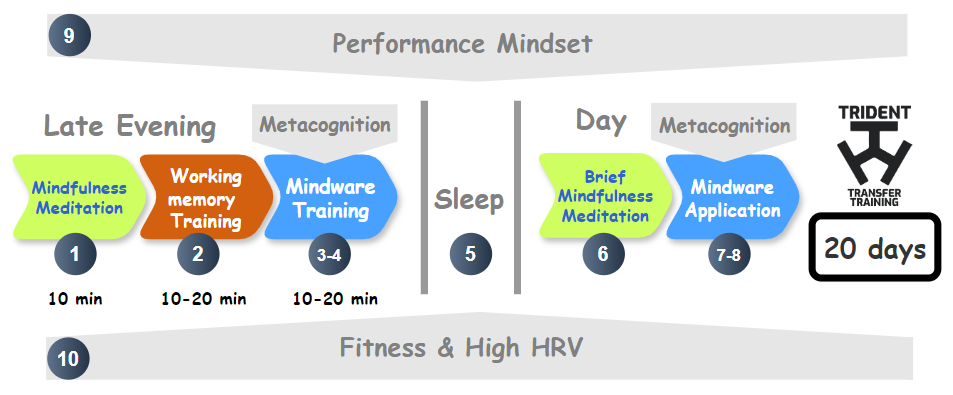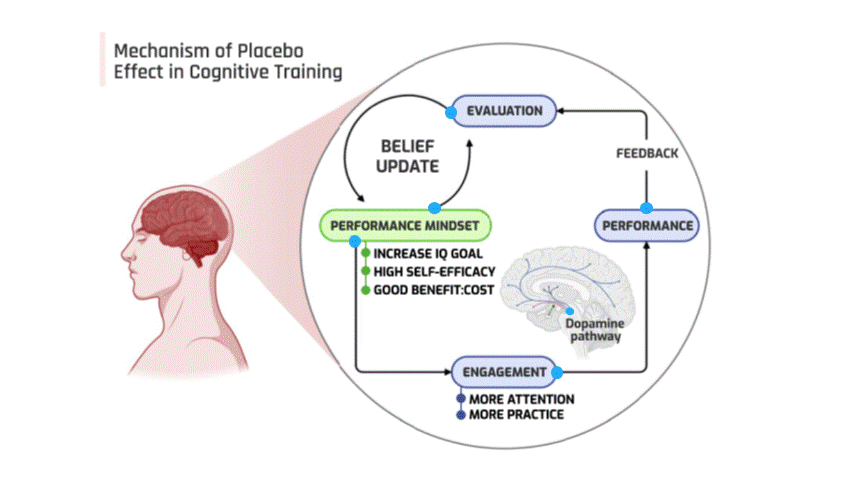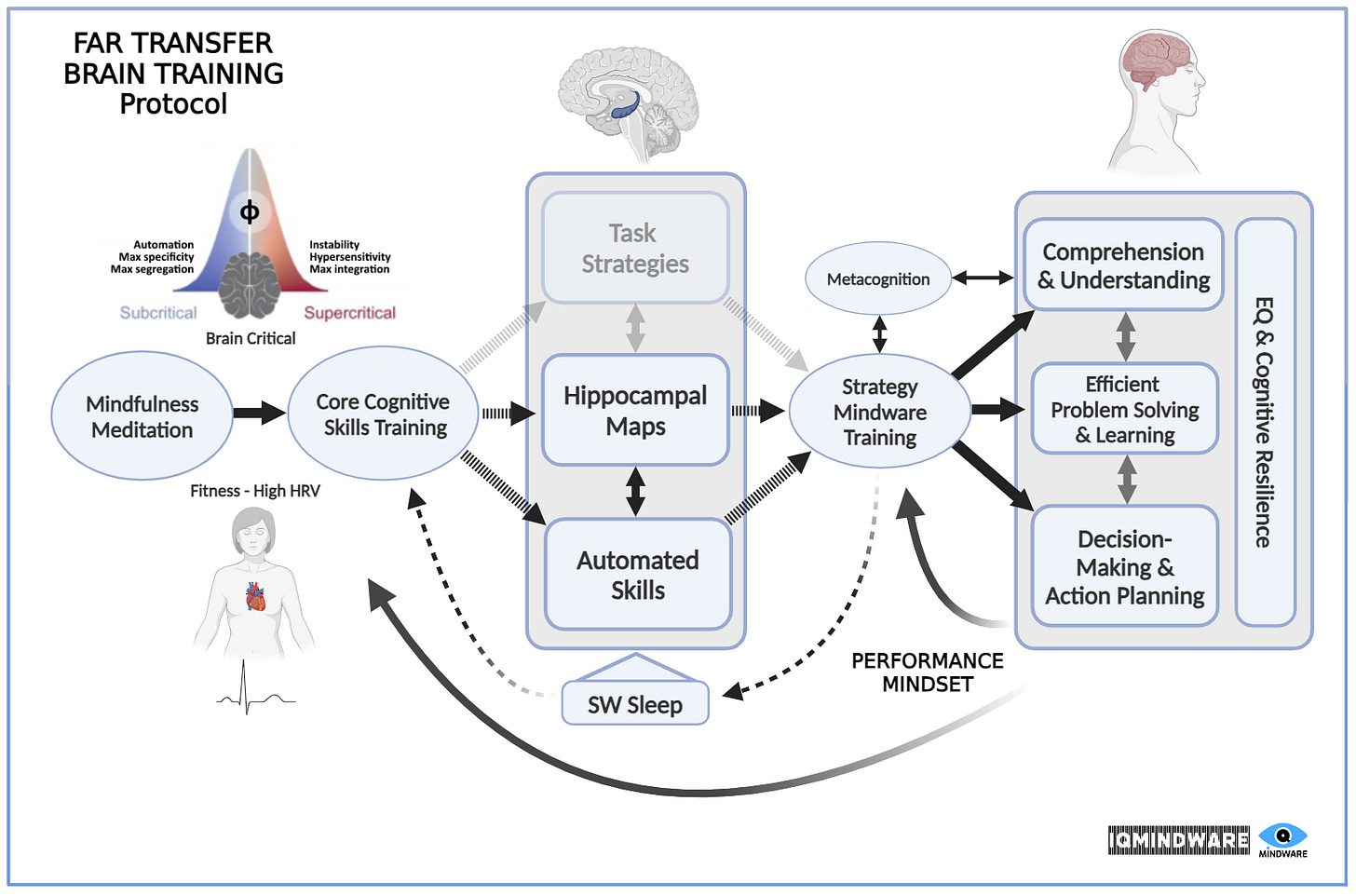Effective Brain Training To Increase IQ & EQ in 3 Diagrams
Intelligence-Increasing Brain Training: Proven, Effective, Trusted
My name is Dr Mark Ashton Smith. I am a cognitive neuroscientist trained at the Center for the Neural Basis of Cognition. For a number of years I was a lecturer and researcher in the Psychology Department at the University of Cambridge, and I am currently a Lecturer in Cognitive Psychology & Neuroscience at the University of Essex Online. I have been researching cognitive interventions and the principles of effective brain training for two decades. Research in the past few years in cognitive neuroscience has been remarkably helpful in figuring out what works and what doesn’t work. The information in this article summarises key findings from my research.
The Hard Problem for Brain Training: Far Transfer
Many brain training programs promise to boost cognitive skills like working memory. And while it is true that you can get better at specific tasks through practice, the problem is that in mainstream brain training these gains don't translate to improvements in other, more valuable areas of life. For example, you might get really good at a short-term memory game, but that doesn’t necessarily mean you'll see improvements in your day to day problem-solving, decision-making or learning. This is called ‘far transfer.’
This issue isn't just limited to working memory - it's a broader problem that affects other cognitive abilities like attention, reasoning, and creative thinking.
The big question is: why do these skills seem so ‘sticky’ and locked into the specific tasks you practice? And more importantly, what does it take to make sure that the benefits of brain training actually transfer to general gains in IQ and the benefits of this for real cognitive challenges that matter most to us?
Effective Brain Training for Far Transfer
Effective brain training, based on my research and the latest findings in cognitive neuroscience, can be summarised in three figures. The first is the brain training protocol for effective ‘far transfer’ from your training. The second and third figures illustrate the explanatory mechanisms behind the effectiveness of this protocol.
The Brain Training Protocol
Mindfulness: In the evening, before beginning your working memory (DNB) or attention training session, you can practice a mindfulness meditation session. This should be open monitoring (OM) mindfulness, trained via a focused attention (breath counting) mindfulness foundation. This helps you achieve a brain critical state, enhancing your brain's capacity for dynamic reconfiguration and neuroplasticity during the subsequent dual n-back training.
Skill Training Phase: During dual n-back training, the brain's segregated networks are consolidated over time, refining model-free routines. These routines, reinforced by prediction error signals, become more efficient and automatic, contributing to the development of crystallised intelligence. This training phase increases your cognitive efficiency.
Mindware Strategy Training Phase: In the mindware training phase (e.g. using decision trees in your minds eye or problem solving methods) the brain's integrated networks tap the efficient working memory skills in new, complex decision-making and problem-solving scenarios. Due to a hippocampal coding mechanism (see below), the autopilot skills developed during n-back training can be flexibly deployed while you practice using these high level strategies. This training phase increases your cognitive capacity.
Metacognition: Metacognitive practices such as self-explanation and reflective reasoning are always applied while training with and applying the mindware. This also helps with the transfer of your app-based training.
Sleep: You ensure that you get restful and regular sleep - particularly slow wave, deep sleep - while you are training to harness the learning and consolidation benefits of sleep.
7. 8. Daily Mindware Application: To maintain the brain in a near-critical state during daily cognitive challenges, you practice brief mindfulness ‘reset’ prior to applying your mindware to get in the zone for making decisions or solving problems. Applying your training to real life demonstrates the effectiveness of the training, helping with your performance mindset.
Having a performance mindset and expectations of success (9) is critical to the success of the training program. You need to look at this and decide protocol after reviewing the evidence and ask yourself: ‘Am I convinced this can be effective in raising my IQ?’ And ‘Can I invest the necessary time and effort into this program (roughly 20 days x 30 minutes) to see it to completion?’ Optionally, you can also work at raising your general fitness and Heart Rate Variability (HRV) which also benefits neuroplasticity for training gains, EQ and cognitive resilience (10).
There are guides for each of these steps in the Trident g program itself.
Explanations
So why does this protocol work? Let’s look at the mechanisms that explain its effectiveness next.
The first mechanism explains why mainstream brain training can help us.
Mechanism 1: Performance Mindset & Placebo Effect
This model shows us how expectations can significantly enhance cognitive performance in the context of brain training. This model highlights the interplay between belief, engagement, and feedback in creating a self-reinforcing cycle that boosts IQ, measured by valid IQ tests, by 5-10 points - even in the absence of actual task-specific gains in cognitive skills. [Research articles: 1, 2]
1. The Performance Mindset
Role in Training: Central to this model is the performance mindset, which is triggered by the belief that cognitive training can increase IQ. This mindset is composed of several key beliefs:
Increase IQ Goal: The belief that enhancing intelligence is valuable and achievable.
High Self-Efficacy: Confidence that one's efforts will lead to improved performance.
Good Benefit to Cost Tradeoff: The belief that the training is effective and the effort invested in training will yield significant returns in terms of cognitive gains.
When these beliefs are strong, they drive deeper engagement in the training tasks, leading to more focused attention and better quality practice, which in turn results in better cognitive performance, increasing IQ.
2. Engagement and Feedback Loops
Role in Training: The model shows that when individuals are engaged in cognitive tasks with a performance mindset, they are more likely to pay attention and practice with more skill. Positive feedback from these efforts, whether through in-game rewards or perceived improvements, reinforces this engagement.
Connection to Cognitive Training: This positive feedback loop, often referred to as a virtuous cycle, strengthens the performance mindset. The ongoing cycle of belief, engagement, and positive feedback can lead to continued cognitive performance improvements, even in areas beyond the specific training tasks - as reflected in improvements on IQ test scores in the research.
3. Dopamine and Reward Pathways
Role in Training: The model also highlights the role of dopamine, a neurotransmitter associated with the brain's reward system, in reinforcing the performance mindset. Dopamine is released when individuals anticipate or experience positive outcomes, such as improved cognitive performance, thereby enhancing motivation and task engagement.
Connection to Cognitive Training: The dopamine-driven reward system can be activated not only by actual performance gains but also by the belief in training efficacy. This means that even placebo-driven expectations can lead to real increases in cognitive performance, as dopamine reinforces the cycle of engagement and positive feedback.
4. Long-Term Effects and Neuroplasticity
Role in Training: Over time, the sustained engagement and motivation fuelled by dopamine-driven feedback loops may lead to lasting changes in brain structure and function, a process known as neuroplasticity. This can result in more permanent cognitive improvements and a stronger, more resilient performance mindset.
Connection to Cognitive Training: Although initial gains may be placebo-driven, the long-term effects can solidify these gains into more stable cognitive abilities, potentially leading to broader improvements in general cognitive performance.
In summary, the performance-mindset model explains how the placebo effect in cognitive training can create a powerful self-reinforcing cycle of belief, engagement, and feedback that leads to real, measurable IQ gains of 5-10 points. By leveraging the brain's reward pathways and the reinforcing nature of dopamine, this model explains how even the expectation of improvement can lead to measurable increases in cognitive performance. While the actual training tasks may have limited efficacy in boosting general intelligence, the mindset and motivation driven by placebo effects can result in significant, long-term cognitive benefits.
Mechanism 2: Far Transfer Brain Training
This next model illustrates how IQ Mindware brain training can go beyond the placebo effect of mainstream brain training to increase IQ.
1. Mindfulness Meditation
Role in Training: Mindfulness meditation can tune the brain for optimal cognitive functioning, transitioning to a brain state called brain criticality (ϕ - phi). In a brain critical state, information processing capacity is maximised and the brain can dynamically reconfigure itself, balancing efficiency and flexibility. This is key to enabling the brain to adapt model-free routines into more complex, strategic contexts, thereby supporting far transfer.
The Science: Mindfulness meditation has been shown in multiple studies to heighten brain criticality, promoting the flexible integration and segregation of neural networks. This helps with the dynamic adaptability and cognitive flexibility needed for far transfer. [Research articles: 1, 2, 3, 4, 5]
2. Core Cognitive Skills Training
Role in Training: This involves training with adaptive brain training games such as dual n-back tasks that over a number of weeks automates high level cognitive routines such as working memory updating that are common to many problem solving and decision-making tasks.
The Science: This phase corresponds to the model-free learning process, where repeated practice leads to the automation of skills. [Research articles: 1, 2, 3]
3. Automated Skills: Efficiency Gains
Role in Training: These are the skills developed during the core cognitive skills training (such as the dual n-back), which become automated, needing minimal cognitive load, allowing for substantial efficiency gains. The automated skills can then be drawn on for flexible strategy application for fluid intelligence (IQ) via predictive cognitive maps in the hippocampus. They are essential for efficient task performance and form the basis of our so-called crystallised intelligence.
The Science: Automated skills are the outcome of successful model-free learning. They are supported by segregated brain networks, which operate efficiently within specific domains, contributing to crystallised intelligence. [Research articles: 1, 2]
4. Strategy Mindware Training: Capacity Gains
Role in Training: Task strategies involve higher-level cognitive processes that involve context sensitivity, planning and flexibility. This phase focuses on developing flexible cognitive strategies (mindware) that can be applied across various contexts. It involves higher-order thinking and the integration of skills into broader cognitive frameworks for comprehending, strategic action planning, problem solving & learning.
The Science: Mindware training is essential for achieving far transfer, as it involves applying automated skills strategically in novel, complex tasks. It relies on the integration of segregated and integrated brain networks, supported by the SR framework and hippocampal maps (see below). [Research articles: 1, 2]
5. Hippocampal Maps
Role in Training: The hippocampal maps are critical for creating cognitive representations that link learned routines to future tasks. These maps help bridge the gap between model-free skill automation and model-based strategic flexibility, supporting far transfer.
The Science: Hippocampal cognitive maps encode predictive ‘Successor Representations (SRs)’ which support recruiting the automated core cognitive skills for the flexible mindware strategies, helping generalise conventional skills-based brain training to different IQ-demanding contexts for far transfer. In other words, these maps connect the flexible strategies from mindware training with the predictive sequences learned during core skills training, ensuring that even automated routines can be adapted to new and varied contexts. [Research articles: 1, 2, 3]
6. Task Strategies
Role in Training: While some strategies developed during skill-based training, such as chunking in dual n-back tasks, can coordinate with mindware strategies by providing foundational cognitive routines, these strategies should only play a role in far transfer if they help the mindware strategies or enhance broader cognitive tasks. They should be de-emphasised when they are too specific to the core skills training. The important task strategies that need to be learned should be based on shared high level routines between the training game and the mindware which can generalise to working memory and attention based problem solving & learning.
The Science: Task based-strategies are known to create discontinuous performance transitions in adaptive brain training games, with initial performance dips followed by a higher level of capacity in the game, which can develop its own skill-based efficiencies. [Research article: 1]
7. Metacognition
Role in Training: Metacognition involves the ability to contextualise, monitor, control, and plan our own cognitive activities. During mindware training, metacognition plays a critical role by helping us assess the effectiveness of the strategies we are using, adapt these strategies to new tasks, and reflect on our thinking processes to improve our problem-solving and decision-making. During application of training in real life, metacognition also helps us with situational awareness - knowing when a situation can benefit from applying the training mindware in a more analytic way.
The Science: Metacognitive practices, such as self-explanation and reflective reasoning, are crucial for effectively applying mindware strategies, as highlighted in the article. These practices help individuals not only understand what strategies to use but also how and when to apply them, making strategies more adaptable and effective in novel situations. By incorporating metacognition, individuals can better manage cognitive load, ensuring efficient use of cognitive resources, which supports the transition from model-free to model-based processes. Ultimately, metacognition helps bridge the gap between specific skills and general strategies, enabling far transfer by ensuring that strategies are applied flexibly and effectively across diverse tasks. [Research articles: 1, 2]
8. Sleep
Role in Training: Sleep is an integral component of the cyclic process of skill and strategy mindware training. During sleep, particularly slow-wave sleep (SWS), the brain consolidates the skills and strategies developed during the day. This consolidation process is essential for strengthening the cognitive maps and automated routines formed during core cognitive skills training. Sleep also plays a critical role in integrating these routines with the flexible strategies learned during mindware training, ensuring that both skills and strategies are refined and adaptable for use in broader, real-world problem-solving and decision-making tasks.
The Science: During SWS, the brain engages in offline replay, where the hippocampal maps and predictive state representations (SR maps) are differentiated and strengthened. This not only solidifies memory but also optimises the brain's ability to apply these skills and strategies across different contexts. By making this consolidation process part of the training cycle, sleep ensures that the gains from both skill-based and strategy-based training are effectively integrated, leading to improved cognitive performance in novel situations. [Research articles: 1, 2, 3, 4]
9. Comprehension & Understanding, Efficient Problem Solving & Learning, Decision-Making & Action Planning
Role in Training: These elements represent the cognitive outcomes of successful far transfer training. They are the real-world applications of the skills and strategies developed during the training process.
The Science: These outcomes reflect the application of strategy-based fluid intelligence (Gf) and skills-based crystallised intelligence (Gc) in real-world tasks, supported by the brain's ability to dynamically reconfigure itself and integrate learned routines into broader cognitive strategies.
10. EQ & Cognitive Resilience
Role in Training: Emotional intelligence (EQ) and cognitive resilience are enhanced through the training process, leading to improved adaptability and stress management, which are crucial for applying cognitive skills in diverse situations.
The Science: The development of EQ and cognitive resilience is supported by mindfulness practices that disengage self-related evaluations, learning to balance cognitive load during training and attention control with skills-based training, and cognitive reframing from mindware training and the performance mindset. These cognitive and affective gains can help with cognitive resilience and the application of the cognitive gains from training over a wider range of stressful task-demands. [Research articles: 1, 2, 3]
11. Fitness & High HRV
Role in Training: Physical fitness and high heart rate variability (HRV) support overall cognitive health, resilience, and flexibility, which are important for the success of the far transfer training.
Connection to the Article: High HRV and physical fitness enhance neuroplasticity and the brain's ability to adapt, contributing to the overall effectiveness of the far transfer training. [Research articles: 1, 2, 3, 4, 5, 6]
12. Performance Mindset
Role in Training: A performance mindset, supported by self-efficacy and a positive evaluation of the training process, enhances engagement and the likelihood of achieving far transfer.
The Science: This is explained by the first figure and the section above. A performance mindset is crucial for deep engagement in the training tasks, which in turn supports the development of both automated skills and strategic cognitive processes necessary for far transfer. [Research articles: 1, 2]
Conclusion:
The far transfer diagram above represents an integrated approach to far transfer brain training, where mindfulness, core cognitive skills, strategy mindware and metacognition, sleep and a performance mindset work together in a cyclic process to enhance both crystallised and fluid intelligence and overall IQ. This process is supported by the SR framework, hippocampal maps, and dynamic brain network reconfiguration. Sleep, as a key part of this cycle, consolidates and integrates the skills and strategies developed during training, ensuring they are adaptable and applicable in real-world tasks. Additionally, the development of emotional intelligence (EQ), cognitive resilience, and physical fitness further supports the brain's ability to adapt and thrive under various cognitive demands, making the training process more effective in promoting overall cognitive health and performance. This approach ultimately improves both IQ (comprehension, problem-solving, decision-making) and overall cognitive resilience.
Visit IQMindware.com to sign up.





